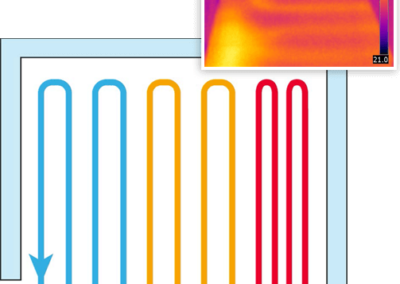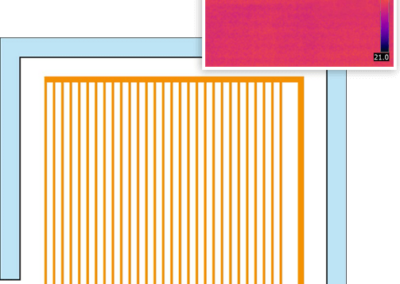In the summer, you sit in your apartment. Outside it is 30° C and there is no cooling in sight. It’s way too warm in your apartment. A cool down is needed. Air conditioning is not an option for you. It gives you a headache every time, your eyes burn, the air is way too dry and you catch a cold quickly. Besides, everyone has a different sense of a “refreshing” temperature – you want to spare yourself that discussion. So what are you supposed to do?
How about surface cooling? This involves cooling the room through the surfaces on the walls, ceiling and/or floor by transferring the excess body heat as well as heat in the air to the cold surfaces. In addition, people also give off body heat to the cool surfaces.
As a result, a so-called radiation exchange takes place and a pleasant indoor climate is created. Since the human body can slowly adapt to the room temperature through heat exchange, this type of cooling is perceived as particularly beneficial.
You may not be able to imagine it yet, but that’s about to change. Everything I tell you in this post comes from over 20 years of experience and over 3500 surface cooling projects. For our customers, one thing is certain: panel cooling systems provide an all-round feel-good climate on hot days. In this article, I’ll tell you why this is so, what advantages panel heating has, and the most important things to know before buying and installing it.
Surface cooling: Radiation exchange creates cooling
The operation of surface cooling is not so difficult: it uses the principle of surface heating. Then everything is clear, isn’t it? If not, I’ll now explain the 3 ways heat can be transferred. After that, I will go into more detail about how a surface cooling system works.
The 3 ways of heat transfer:
- #1: Convection (=heat flow): In this form, heat is transferred via air currents. An example of this is a classic radiator. The air above the radiator is heated. The warm air rises while the cooler air sinks. This is then heated again by the radiator and a steady circulation of air is created.
- #2: Heat conduction: Conduction of heat heats bodies through direct contact. If you turn on your stove top and put a pot on it, it will get hot due to conduction.
- #3: Heat radiation: Heat is transferred by means of infrared radiation – i.e. electromagnetic waves. How much heat a body radiates depends on its temperature (and also the temperature of the “receiver” – in this case wall, ceiling or floor). If there is no receiver that can receive heat (i.e. a colder object), it does not radiate heat but receives it. For example, thanks to heat radiation, you can sit outside with a T-shirt on even in winter when the sun is shining directly on you.
How does the radiation exchange of a surface cooling system work?
Pipe systems are laid either helically, serpentine or running parallel under the flooring, in walls or ceilings.Cold water is pumped through the pipes, cooling the surfaces.
When you enter the room, your body has a higher temperature than the surfaces. Heat goes from the warm to the cold areas, so your body transfers its heat to the cold surfaces.
As your body temperature slowly adjusts to that of the room, you feel a pleasant cooling effect. Unlike a classic air conditioner, surface cooling does not act selectively, but affects the entire body.
If you’re interested in exactly how it works, you can also watch our video about it:
The question remains: Where can you install surface cooling everywhere?
What are the types of surface cooling systems?
- Floor cooling: If you choose floor cooling, the pipe system is installed in your floor. In this case, the heat is conducted into the ground.
Wall cooling
: The pipe system is installed behind the walls. Here you should make sure that the temperature of the water is between 16 °C and 20 °C to cool the room optimally. Attention, these are only average values – the “correct” temperature depends primarily on the area size and external conditions.
Ceiling cooling
With ceiling cooling, the system is installed in the ceiling. Here, too, you should maintain a water temperature of 16 – 20 °C. Again, this is only an approximate value. The exact temperature setting depends on your cold sensation.
No matter what type of surface cooling you choose, somehow the water has to be cooled. What if I told you there was a system that would allow you to run your surface cooling without an energy-guzzling chiller? This way you reduce your energy costs to almost 0 cents.
Almost no energy costs with surface cooling
On hot summer days you would like to hide in the cellar all day. There are temperatures around 15 degrees Celsius even in summer. You can take advantage of this “natural cold”. How?
First, you install the pipe system for surface cooling in your house or apartment. Then you install another pipe system – a so-called cold generation surface – in the basement. Alternatively, you can install the pipe system underneath the house before the house is built. These two systems are interconnected.
In the basement, the water is cooled naturally by the temperature of the environment. Now, if you get too warm in the living quarters, the cool water from the basement is pumped into the pipe system in the house or apartment. The warm water of the living rooms flows into the basement for cooling.
Once the water has cooled down again, it is once again fed into the living quarters and so on…. So you can cool your rooms almost for free.
If you find the installation of such a cooling surface too costly or installation is not possible, you can also rely on an electric heat pump. This can be used for cooling in summer and heating in winter.
No matter which of the two cooling options you use, you will lower your energy costs in any case: If you use surface cooling, you have to cool the surfaces to about 26 °C in order to feel comfortable. With a conventional air conditioner, it is about 23 ° C, because only then the air flow reaches every corner.
Every degree of lowered room temperature with air conditioning means 10% more energy costs for you. Consequently, with surface cooling you save about 30% of the costs if you bring about cooling via an electric heat pump.
If you rely on cooling with “natural” cold, you can reduce energy consumption to an absolute minimum.
In addition to the savings in energy costs, you have other advantages with a surface cooling system.
5 Advantages of surface cooling
In a separate blog post, we detailed the benefits of surface cooling. I’ll summarize them for you here:
Advantage #1: Healthy climate
Thanks to the exchange of radiation, people and furniture are illuminated by the coolness and the heat is transferred. Air circulation is thus reduced to a minimum, the air is less dry and dusty. Surface cooling is therefore particularly suitable for allergy sufferers and asthmatics, but of course everyone in the house benefits.
Advantage #2: No mold
For mold to grow, 2 conditions must be met: humidity and a cold surface. With surface cooling, surfaces never reach a temperature below 15 °C, but usually remain between 19 – 21 °C. If there are no cold surfaces, the moisture in the air can also not condense and therefore mold does not develop.
Advantage #3: Free interior design possibilities
Surface cooling systems are installed virtually invisibly and are integrated into the surfaces. So you can design the room however you want and not have to worry about mold or finding the pipes.
Advantage #4: Protects the environment
Conventional air conditioner – as already mentioned – need more energy. This requires resources from the environment. The more energy you use to cool your home, the more environmentally damaging it is. Surface cooling reduces your energy needs; even more so with ground or basement cooling. This way you save the environment.
Advantage #5: Cooling and heating
Some surface cooling systems can be used as surface heating systems in winter. In this way, you ensure a pleasant indoor climate even in winter. The operation and advantages remain the same, only the water temperature is increased by a few degrees.
What should you consider before buying or installing a surface cooling system?
Before purchasing a surface cooling system, you should ask yourself the following questions:
- What kind of surface cooling do you want to install?
- Do you live in a new or old building?
- How many square meters do you want to cool?
- What is the possible build-up height?
- Especially for floor cooling: Is the flooring suitable for installation?
- Especially for wall and ceiling cooling systems: Are the surfaces sufficiently insulated?
- Do you install the cooling system yourself or does a professional do it?
- Which pipe system do you want to use? Serial (serpentine or spiral) or parallel running (Tichelmann system)?
- What kind of mounting do you choose? (staple system, stud system)
You must be absolutely sure that you have a suitable floor covering for conventional floor cooling systems. It is essential that wall cooling systems are sufficiently insulated. The wrong choice can have devastating consequences.
That’s why you should consult a professional who can give you comprehensive advice and choose the right surface cooling system for your needs. But it is also easier!
I will now introduce you to a system that is easy to install, suitable for any type of building and sustainably reduces your energy costs: the “egger system”.
Cooling with the egger system: suitable for any type of building or structure
We have been installing surface cooling systems with the egger system for over 20 years. What are the advantages of our system?
Our surface cooling systems are suitable for any type of building: from old buildings, new buildings to self-built homes. Whether apartments, houses, restaurants, schools, workshops or production areas – with egger’s surface cooling systems you can really keep any room at a pleasant temperature.
If you choose an egger cold generating area in the ground or in your basement, you will save yourself a lot of money on energy costs.
Our cooling systems are based on the Tichelmann system. This means that the pipes are not laid serially (serpentine) or helically as is usually the case. We rely on a parallel pipe system with a pipe spacing of 8 cm. Thus, there are no temperature waves, as in conventional panel heating (“hot-cold-cold effect”).
If you want to create a pleasant feel-good climate in your rooms even in winter, egger systems are exactly what you are looking for. Indeed, inthe winter they can be used as panel heaters.
Another advantage: With egger surface cooling systems, you reduce the lead time to a minimum. Within a very short time, your rooms will be noticeably cooled down.
Conclusion: The egger system ensures even temperature distribution to create an ideal feel-good climate for everyone – winter and summer alike. At the same time you do something good for the environment and save money.
You want to learn more about the egger system and our surface cooling systems?
Do you still have questions about our products or do you already want to inquire about your options for surface cooling? Feel free to contact us by phone(+43 5223 411 68 11), by e-mail or via our contact form. We will advise you during a free initial consultation and take a close look at your situation as well as your needs.
By the way, in our egger Wohlfühl-Klima Shop you will find an overview of all our surface cooling systems (which also serve for surface heating) with the accessories for self-installation. You can buy floor heating, buy wall heating and buy ceiling heating. To make sure you succeed, we provide a step-by-step guide.
Love greetings
Annette & Christian Egger





